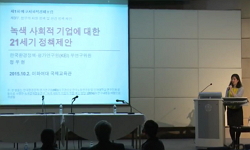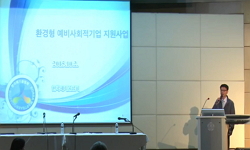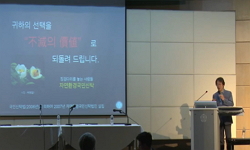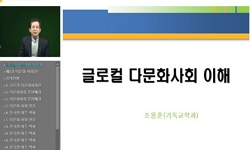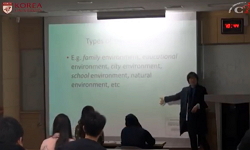This study began with the aims to find out how Donghak Peasant War is reflected in 「Kabo-nongminjonjaeng」 and 「Nokdu-jangguri」 - the greastest historical novels of north and south Korean literature - through the analysis of their historical en...
http://chineseinput.net/에서 pinyin(병음)방식으로 중국어를 변환할 수 있습니다.
변환된 중국어를 복사하여 사용하시면 됩니다.
- 中文 을 입력하시려면 zhongwen을 입력하시고 space를누르시면됩니다.
- 北京 을 입력하시려면 beijing을 입력하시고 space를 누르시면 됩니다.
https://www.riss.kr/link?id=T3480565
- 저자
-
발행사항
공주 : 공주대학교 교육대학원, 1997
-
학위논문사항
학위논문(석사)-- 공주대학교 교육대학원 : 국어교육전공 1997. 2
-
발행연도
1997
-
작성언어
한국어
- 주제어
-
DDC
411
-
발행국(도시)
충청남도
-
형태사항
237 p. ; 27 cm
- 소장기관
-
0
상세조회 -
0
다운로드
부가정보
다국어 초록 (Multilingual Abstract)
This study began with the aims to find out how Donghak Peasant War is reflected in 「Kabo-nongminjonjaeng」 and 「Nokdu-jangguri」 - the greastest historical novels of north and south Korean literature - through the analysis of their historical environments and characters and to draw what relation the differences between two novels have to the literary views in the structure of north and south Korean societies as well as the writers' historical views.
A research of the historical environments was focused on political, economic, social, and cultural environments(including the thoughts).
In other words, it was focused on the formation of the causes of Donghak Peasant War.
The analysis factors are :
a) political environment : central government by royal family and ministers, local government by local officials and their petty officials, international situations and Choson's confrontation to them, and many popular uprisings.
b) economic environment : common people's miserable lives, tax system and the tax exploitation by local officials, economic trends of the late period of Choson, and the aspects of the invasion of foreign capitalism.
c) social environment :status system, tenant system, and robbers' movement.
d) cultural environment : religion(thought), Court culture and governing system, education, customs, language, and people's lives.
How were the factors of the political environment described in the two novels?
In 「Nokdu-janggun」, the Court and central government were usually described to show the change of events and the government's confrontation to the proceeding aspects of the Peasant War.
In 「Kabo-nongminjonjaeng」 , however, the description of central government shows motives of the Donghak Peasant War much better than the former and it occupies as much as people's life-bond.
Both novels described the local officials' tyranny and the people's uprising concretely because the tyranny was the most concrete motive of the Peasant War. The former has much more descriptions about economic invasion by imperialism than political invasion. On the contrary, the latter described the political agressive ambition very strongly.
「Kabo-nongminjonjaeng」 described the common people's lives Concretely and directly whereas 「Nokdu-janggun」 did symbolically and abstractly with a dramatic method.
The former writer gave evidence of Chinese(Ch'ing Dynasty) and Japanese economic plunder and cultural invasion with his unique description and tedious narration.
The latter writer gave evidence of the seriousness by showing some pieces of fact with a dramatic method.
「Nokdu-janggun」 didn't describe Yangban(nobleman)'s arrogance and the contradiction of status system as completely as 「Kabo-nongminjonjaeng」.
Lee, Ju-ho in 「Nokdu-janggun」 is not a character who can assimilate both sides of dignity and exploitation.
On the contrary, Lee, Jinsa in 「Kabo-nongminjonjaeng」 , who is a landlord and noblem an, is a typical vicious landowner in a north Korean old revolutionary novel and this character shows the contradiction of feudalism very well.
The thought background of 「Nokdu-janggun」 is much broader in quantity and quality than that of 「Kabo-nongminjonjaeng」 .
It is not too much to say that it is a museum of oriental religions because it is made up of so many thoughts and beliefs - there are not only Catholicism, Buddhism, Confucianism, and Taoism around Donghak (Eastern science) but also popular beliefs such as Chonggamrok, the Merciful Buddhism, the theory of geomancy and Namhae-jinin-sul and even Cheungsanism and Pochonism.
Among the cultural factors of governing class in 「Kabo-nongminjonjaeng」, the Court culture is the best described in its quality and quantity.
But 「Nokdu-janggun」 is short of the description of a governing class culture.
The aspects of popular culture are similar in both of them but that of 「Nokdu-janggun」 is superior in its quantity and depth.
The common popular culture described in both of them are Dure(farmer's cooperative group), Pansori, Sadangpae(a troupe of song-and-dance girls), Deungso, folk remedies, and so on.
The analysis of characters had the aims to draw their heroism and popularity by analyzing the features of characters in class and to examine distinguishing marks and differences in shaping the characters of the two novels.
I divided the characters into two groups, populace class and governing class and analyzed the each character's action, Personality and the role in the novels.
In result, the characters in both novels are divided into populace class and governing class.
And these novels show their antagonistic relationship that are hostility and struggle, though there are dual characters such as the conscientious intellectuals from the governing class, who are in favor of Peasant War, and the populace class who work for the governing class as their faithful servants and hands.
On the basis of the above analysis, I investigated the two novels' qualities and differences that appeared in the process of creation and description of characters. First, here are some common qualities :
1. There was used the dualistic method of character classification.
There were two types of person - the governing class and the populace class.
2. 「Kabo-nongminjonjaeng」used a telling method and 「Nokdu-janggun」used a showing method in describing characters.
3. In establishing characters, they held to the principle of bloodline that faithful family makes a loyal subject and rebellious family makes a rebel.
4. The character plot established the successors clearly.
5. The description of appearance are in accord with that of personality.
And it has some formation by classes.
Second, here are some uniqueness of 「Kabo-nongminjonjaeng」 :
1. Characters were classified. Each character didn't have his individual personality, so the character's personality, class and role were simplified and unified in classes. There were not individuals but classes.
2. The description of character's appearance and personality was subjective because of emotion interruption
3. Too much broad description of characters' intercommunication raises the reader's doubt.
4. The plot was progressing around one hero.
Common people and the leader, Chon, Bong-jun were made like heroes and they seems to be supermen.
5. The establishment and description have more romantic tendency than realisdc.
Last, here are the uniqueness of 「Nokdu-janggun」:
1. The characters were established in triple system. Main characters leading the Peasant War were divided into three types - rational, neutral, and passionate persons.
2. The description of common people's Personality and action is realistic and concrete.
The characters were bestowed marked individualirics and show many various popular features.
And it keeps the balance by arranging the positive and negative aspects of common people.
목차 (Table of Contents)
- 目次 = 0
- Ⅰ. 序論 = 1
- 1. 硏究의 意義 = 1
- 2. 硏究史 槪觀 = 4
- 3. 硏究 方法 = 7
- 目次 = 0
- Ⅰ. 序論 = 1
- 1. 硏究의 意義 = 1
- 2. 硏究史 槪觀 = 4
- 3. 硏究 方法 = 7
- Ⅱ. 歷史小說과 東學農民戰爭 = 10
- 1. 歷史小說의 諸 問題 檢討 = 10
- 2. 東學農民戰爭과 歷史小說 = 13
- 3. 「갑오농민전쟁」과 「녹두장군」 = 16
- 1)「갑오농민전쟁 = 16
- 2)「녹두장군」 = 22
- Ⅲ. 歷史的 環境 分析 = 26
- 1. 문제 제기 = 26
- 2. 19C의 政治, 經濟, 社會, 文化的 樣相 = 28
- 3. 政治的 環境 分析 = 32
- 1)중앙징치의 타락과 부패 = 32
- 2)지방수령의 학정과 민란 = 36
- 3)국제정세와 척양척왜 = 40
- 4. 經濟的 環境 分析 = 45
- 1)비참한 민중의 생활 = 45
- 2)조세제도와 조선경제의 파탄 = 50
- 3)외래 자본주의 침투 = 55
- 5. 社會的 環境 分析 = 59
- 1)붕괴되는 신분제도와 양반의 횡포 = 59
- 2)전율하는 소작제도-지주전호제 = 69
- 3)창궐하는 화적패 = 73
- 6. 文化的 環境 分析 = 78
- 1)종교와 사상 = 78
- 2)지배계급의 문화 = 91
- 3)민중의 문화 = 98
- Ⅳ. 作中人物 分析 = 105
- 1. 문제제기 = 105
- 2. 民衆階級 = 108
- 1) 東學 接主와 農民軍 頭領 = 108
- (1)「갑오농민전쟁」 = 108
- ①전봉준 ②김개남 ③손화중 ④이방언과 김덕영 ⑤최정선과 김도삼, = 108
- 그리고 정일서 ⑥최시형과 손병희 ⑦서병학과 김경천 = 108
- (2)「녹두장군」 = 119
- ①전봉준 ②김개남 ③손화중 ④김덕명과 이방언 = 119
- ⑤최경선과 정익서, 그리고 김도삼 ⑥최시형과 손병희, 그리고 서장옥 = 131
- ⑦임군한과 임문한, 그리고 임진한 = 135
- (3) 전봉준의 英雄性과 日常性 = 136
- 2) 基層民衆 = 139
- (1)「갑오농민전쟁」 = 139
- ①오상민 ②오수동 ③정한순 ④윤영아 ⑤할머니와 어머니 = 139
- ⑥이복룡과 김봉득, 그리고 염동이 ⑦고부 양교리 주민들 = 152
- ⑧이진사네 머슴과 하인들 = 155
- (2)「녹두장군」 = 156
- ①달주 ②용배와 성삼이 ③연엽 ④만득과 유월래 ⑤김승종과 정길남, = 156
- 그리고 지혜계원들 ⑥김확실과 산적패 ⑦고부 하학동 주민들 = 156
- 3) 基層民衆의 英雄性과 民衆性 = 167
- (1)「갑오농민전쟁」 = 171
- ①이상무 ②이생원 ③강주부 ④심상모 ⑤전창혁 ⑥신상균 = 171
- (2)「녹두장군」 = 176
- ①김덕호 ②이경혹 ③전창혁 ④김학진, 그리고 그 밖의 인물들 = 176
- (3) 良心的 知識人의 典型과 그 意義 = 181
- 3. 支配階級 = 183
- 1) 政治的 支配階級 = 183
- (1)「갑오농민전쟁」 = 183
- ①왕과 왕족 ②중앙정치 계급 ③지방수령 = 183
- (2)「녹두장군」 = 190
- ①황과 왕족 ②중앙정치 계급 ③지방수령 = 190
- (3) 政治的 支配階級의 虐政과 農民戰爭 = 196
- 2) 社會 ? 經濟的 支配階級 = 198
- (1)「갑오농민전쟁」 = 198
- ①이진사 ②송생원 ③고병갑 ④그 밖의 양교리 들 = 198
- (2)「녹두장군」 = 202
- ①이주호 ②정참봉 ③고산 김중한 ④진산 방필만(방학주) = 202
- ⑤그 밖의 兩班들 = 202
- (3) 暴惡한 兩班과 惡德地主의 典型 = 206
- 3) 지배계급의 走狗들 = 208
- (1)「갑오농민전쟁」 = 208
- ①백낙서 ②고부의 아전들 ③김첨지 ④짝쇠 ⑤포도텅 포졸들 = 208
- (2)「녹두장군」 = 212
- ①고부의 아전들 ②정익수 ③이갑출 = 212
- (3) 集團과 個人, 그리고 英雄과 民衆의 美學 = 215
- 4. 作中人物의 英雄性과 民衆性 = 216
- Ⅴ. 結論 = 224
- ※ 참고문헌 = 233
- ※ Abstract = 235






